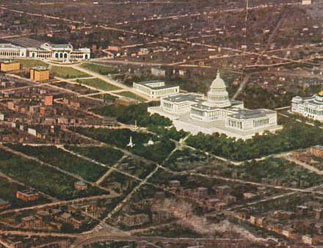
Washington, D.C.
Elms of the National Mall
Courtesy Library of Congress
history (Botanic Garden “Elm”) continued
Congress selected Frederick Law Olmsted, Jr., a member of the McMillan Commission, to implement the redesign of the National Mall. Under Olmsted’s direction, the Union Square of the McMillan Plan had no trees, thus creating a visual break between the trees of the Capital Grounds and those of the Mall. There was, however, strong opposition to this clear-cutting. Olmsted remained well-aware of this sentiment twenty years later, and it likely influenced his decision to incorporate trees into his design for Union Square. Specifically, he directed that, “The existing fine large trees in the old Botanic Garden north and south of the requisite central open space should be preserved, and should be reinforced [sic], where the mass of foliage is weak, by additional trees, obtainable in part by moving to those positions good trees which must be removed from the central open space.” Olmsted hoped to preserve these specimen trees while at the same time adhering to the Mall’s overall “Grand Avenue” theme by showcasing the memorials within the square’s central open space.
From an anecdotal standpoint the plan to preserve the trees within the square was only marginally successful, as approximately 41 trees were transplanted and 250 were cut down. Many memorial and exotic trees were among those lost. Moreover, the installation of the Capitol Reflecting Pool in 1971 by the architectural firm Skidmore, Owings & Merrill, destroyed the majority of the trees planted within the square, forced the removal of the Meade Memorial, and irrevocably altered Olmsted’s design. With Olmsted’s removals, the installation of the reflecting pool, and natural mortality, it appears that very few exotics remain and no memorial trees have survived.